Struggling with tired, strained eyes after a long day of screen time? You’re not alone, and the solution is more advanced than standard eyewear. This guide explains how specialized anti fatigue lenses are engineered to directly combat digital eye strain by reducing muscle fatigue. We will show you how to find immediate visual relief by selecting the right pair, which can be fitted into any stylish frame, including premium japanese acetate frames, to match your personal style.
What Are Anti-Fatigue Lenses?
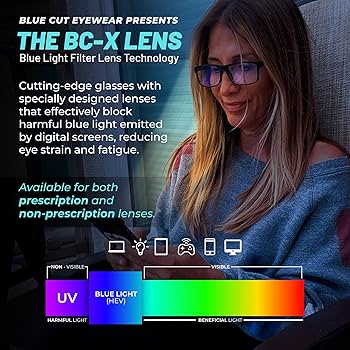
Anti-fatigue lenses represent a specialized solution crafted to combat modern visual demands. They are not standard single-vision lenses, nor are they full progressives. Instead, they occupy a unique middle ground, engineered specifically to alleviate the eye strain associated with prolonged focus on digital devices and other near-vision tasks.
Defining a New Lens Category: Enhanced Single Vision
These innovative lenses are best understood as “enhanced single-vision” or “power-variation” lenses. They provide clear distance vision in the upper portion, just like a standard prescription, but incorporate a subtle power boost in the lower section to support up-close work.
Power-Variation Lenses for Pre-Presbyopes
Anti-fatigue lenses are designed primarily for pre-presbyopes—individuals, often under 40, who experience symptoms of eye strain but do not yet require multifocal correction for presbyopia. The lens features a gradual, slight increase in magnification toward the bottom. This power variation is much less pronounced than that found in multifocal eyewear like progressive sunglasses, making adaptation seamless for the user.
As Defined by BS EN ISO 8980-2 Standards
Industry standards provide a clear technical definition. According to the 2025 update of BS EN ISO 8980-2, these are classified as “enhanced single-vision lenses” due to their low addition power. This ‘add’ power, the extra magnification in the lower zone, typically ranges from +0.40 to +1.25 Diopters, confirming their role as a support lens rather than a full multifocal.
The Core Purpose: Relieving Visual Fatigue
The fundamental goal of anti-fatigue lenses is to reduce accommodative stress, the technical term for the exertion your eye muscles undergo to focus. By providing targeted support, these lenses help prevent the common symptoms of digital eye strain, such as tired eyes, headaches, and blurred vision.
Designed for Prolonged Reading and Digital Screen Use
In our daily lives, we constantly shift focus between our surroundings and our screens. This repetitive effort strains the ciliary muscle inside the eye. Anti-fatigue lenses, such as the popular Essilor Eyezen or ZEISS Digital Lens, are optimized for this exact behavior, offering relief during hours of computer work, reading, or smartphone use.
Restoring Natural Accommodation Patterns
These lenses work by doing some of the focusing for your eyes. The small magnification zone at the bottom of the lens reduces the accommodative effort required for near tasks. This helps your eyes maintain a more relaxed and natural focusing pattern, significantly decreasing the muscle fatigue that builds up over the day. This technology is a direct answer to the visual stress caused by our digital environment. To see how this powerful feature is built into today’s eyewear, you can find various anti-fatigue lens options designed to provide immediate visual comfort.
How Do Anti-Fatigue Lenses Work?
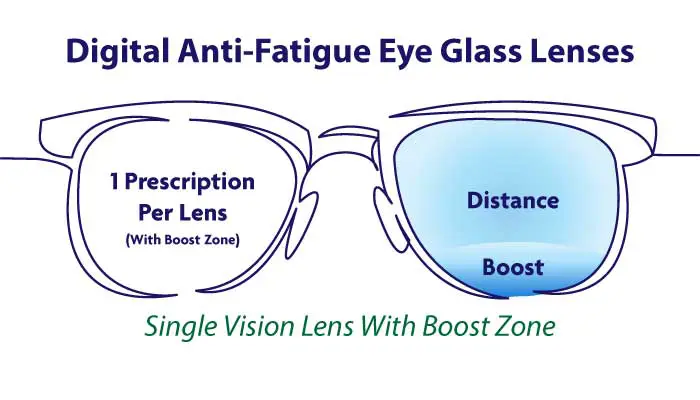
Anti-fatigue lenses function through a sophisticated yet simple principle: providing targeted optical support precisely where your eyes need it most. They are engineered with advanced technologies to reduce the muscular effort your eyes exert during prolonged near-vision tasks, such as looking at a computer or smartphone.
The Science of Accommodation Support
The effectiveness of these lenses is rooted in the science of ocular accommodation—the process by which the eye changes its optical power to maintain a clear image of objects at varying distances. Anti-fatigue lenses provide direct accommodation support to make this process less strenuous.
A Low Power Addition in the Near Vision Zone
The core feature is a precisely calculated low power addition located in the lower portion of the lens. This near vision zone contains a subtle increase in magnification, typically between +0.40 and +1.25 diopters. This boost is just enough to assist your eyes with close-up focus without the significant power shift found in traditional progressive lenses.
Reducing Demand on the Eye’s Ciliary Muscle
Focusing on near objects requires the contraction of the eye’s ciliary muscle. Over hours, this constant effort leads to fatigue and strain. By introducing a power boost, the lens does part of the focusing work, significantly reducing demand on the ciliary muscle and allowing it to remain in a more relaxed state.
Advanced Ophthalmic Lens Technologies
The seamless performance of modern anti-fatigue lenses is made possible by cutting-edge ophthalmic lens technologies. These digital manufacturing and design processes ensure precision, clarity, and comfort for the wearer.
Dual Reference Points for Far and Near Vision
Unlike a standard single-vision lens with one optical center, an anti-fatigue lens is designed with dual reference points. The upper zone is optimized for clear distance or far vision, while the lower zone is engineered to support near vision tasks. This dual-zone design provides the correct prescription for every viewing distance.
Digital Ray-Path and Smart Add Technologies
Modern lens manufacturing utilizes Digital Ray-Path technology to trace light from every angle as it passes through the lens to the eye. This ensures optimal visual acuity and minimizes distortion. Concurrently, Smart Add Technologies seamlessly blend the power addition into the lens, creating a smooth, unnoticeable transition between the distance and near zones. These advancements are now more accessible than ever, making it easier to find high-quality prescription eyeglasses online cheap without sacrificing performance.
Freeform Optimization for Edge-to-Edge Clarity
The final piece of the technological puzzle is freeform optimization. This is a computer-driven surfacing process that fabricates the lens with pinpoint accuracy. The result is superior edge-to-edge clarity and a wider, more comfortable field of view, eliminating the visual aberrations common in older lens designs. These combined technologies deliver a lens that not only corrects vision but actively works to prevent eye fatigue. To see how these innovations are integrated into various lens designs, you can explore a wide range of cutting-edge anti-fatigue eyewear and find the specific technology that will resolve your visual discomfort.
Who Should Wear Anti-Fatigue Lenses?

Anti-fatigue lenses are not a one-size-fits-all solution, but they are designed for a broad and growing demographic. Understanding if you are an ideal candidate is the first step toward finding relief from visual discomfort in our digitally-driven world. The primary users are those whose daily routines demand prolonged focus on digital screens and near-vision tasks.
Identifying the Ideal Candidates for Anti-Fatigue Lenses
Certain lifestyles and age groups benefit more significantly from the accommodative support these lenses provide. If you recognize your daily habits in the descriptions below, anti-fatigue lenses could be a transformative solution for you.
Pre-Presbyopes Aged 18-45
The core group of ideal candidates consists of adults between the ages of 18 and 45. This age group is often referred to as “pre-presbyopes”—individuals who have not yet developed age-related farsightedness (presbyopia) but whose focusing system is under constant strain from digital device use. Their eyes can still accommodate, but the extra support from anti-fatigue lenses prevents overuse and delays the onset of fatigue.
Individuals with Heavy Screen Use and Digital Lifestyles
Modern life is synonymous with screens. Professionals who work on computers all day, students attending online classes, and avid gamers all fall into the category of individuals with heavy screen use. These digital lifestyles require the eyes’ ciliary muscles to work overtime, and anti-fatigue lenses are specifically engineered to lessen this workload and support sustained visual comfort.
Patients Experiencing Digital Eye Strain Symptoms
If you regularly experience symptoms of digital eye strain (DES), also known as Computer Vision Syndrome, you are a prime candidate. These symptoms include tired or sore eyes, headaches, blurred vision after screen use, and even neck and shoulder pain from poor posture. Anti-fatigue lenses directly target the root cause of this discomfort by making near-vision focus less strenuous.
Prescription and User Suitability for Anti-Fatigue Lenses
The versatility of anti-fatigue lenses extends to their compatibility with various prescriptions and users, making them an accessible technology for nearly anyone experiencing near-vision fatigue. They can be seamlessly integrated into most eyewear choices.
Effective for Myopes, Hyperopes, and Emmetropes
These lenses are not limited to a specific type of refractive error. They are highly effective for myopes (nearsighted individuals), hyperopes (farsighted individuals), and even emmetropes—people with perfect distance vision who still suffer from eye strain. The gentle power boost in the lower portion of the lens works independently of the primary distance correction.
Suitable for Users as Young as 12 (e.g., Eyezen Start)
Recognizing that digital strain starts early, lens manufacturers have developed products suitable for users as young as 12. The Essilor Eyezen Start lens, for example, uses a specific technology to help reduce the accommodative effort for children and teenagers who spend hours on tablets and computers for school and entertainment. This proactive approach helps support healthy visual habits from a young age. Once you determine these lenses are right for you or your child, they can be fitted into almost any frame, including timeless and popular styles like rectangle eyeglasses.
If you identify with any of these profiles, from a young student to a professional in their 40s, you are likely to benefit from this technology. To find a pair specifically designed to alleviate your symptoms and match your prescription, explore our collection of advanced anti-fatigue lenses, which will allow you to browse specific technologies and lens powers that directly solve the problem of digital eye strain.
Are Anti-Fatigue Lenses Worth It? The Evidence
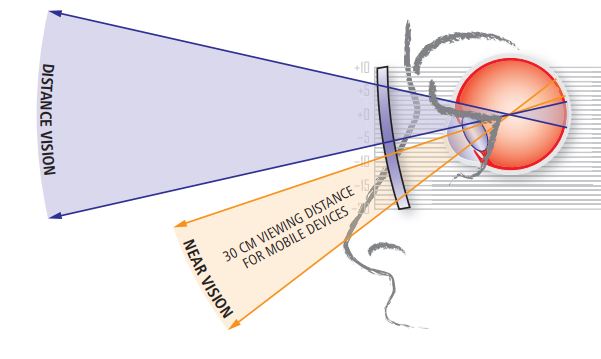
When considering any new health-related technology, the crucial question is always: “Does it actually work?” For anti-fatigue lenses, the answer is supported by both scientific research and strong market trends, confirming their value as a legitimate solution for digital eye strain.
Proven Benefits for Visual Fatigue Relief
The primary claim of these lenses is their ability to reduce visual discomfort. This benefit is not just marketing; it is a measurable outcome that has been validated in clinical settings, providing a solid foundation for their effectiveness.
Significant Reduction in Computer-Induced Asthenopia
Anti-fatigue lenses are engineered to directly combat computer-induced asthenopia, the clinical term for eye strain caused by digital screens. By providing a slight power boost in the lower portion of the lens, they reduce the accommodative effort your eye muscles must exert to maintain clear near vision, leading to a substantial decrease in symptoms like tired eyes, headaches, and fluctuating focus.
Data: Alionis et al. (2020) Study Findings
The efficacy of these lenses is backed by hard data. A key 2020 study published by Alionis et al. provided clear evidence of their benefits. The study findings revealed that participants wearing anti-fatigue lenses reported a statistically significant reduction in the severity and frequency of asthenopia symptoms compared to those wearing standard single-vision lenses during prolonged computer use. This research solidifies their role in providing tangible visual fatigue relief.
A Growing Solution for Modern Eye Care
Beyond the lab, the real-world adoption of anti-fatigue lenses tells a compelling story. They have moved from a niche product to a mainstream component of modern eye care, reflecting a widespread need for digital visual solutions.
Market Adoption: 14% of U.S. Adults Own Them
As of 2025, the market adoption rate is a clear indicator of their perceived value. Data shows that approximately 14% of adults in the United States already own a pair of anti-fatigue lenses. This figure demonstrates that a significant portion of the population has already invested in this technology to improve their daily visual comfort.
User Intent: 11% of U.S. Adults Plan to Purchase
The trend is set to continue. Current market surveys reveal a strong user intent, with an additional 11% of U.S. adults planning to purchase anti-fatigue lenses in the near future. This growing interest highlights an increasing public awareness of digital eye strain and the search for effective remedies. While these lenses are ideal for pre-presbyopes, individuals with more pronounced age-related focusing challenges might also explore options like low cost progressive eyeglasses for comprehensive vision correction.
The combination of scientific proof and growing consumer confidence makes a powerful case for their worth. To see how this technology can specifically address your eye strain symptoms, you can review a curated selection of evidence-based anti-fatigue lenses, allowing you to find a pair that provides the precise visual support you need for your digital life.
Anti-Fatigue Lenses vs. Other Common Lenses
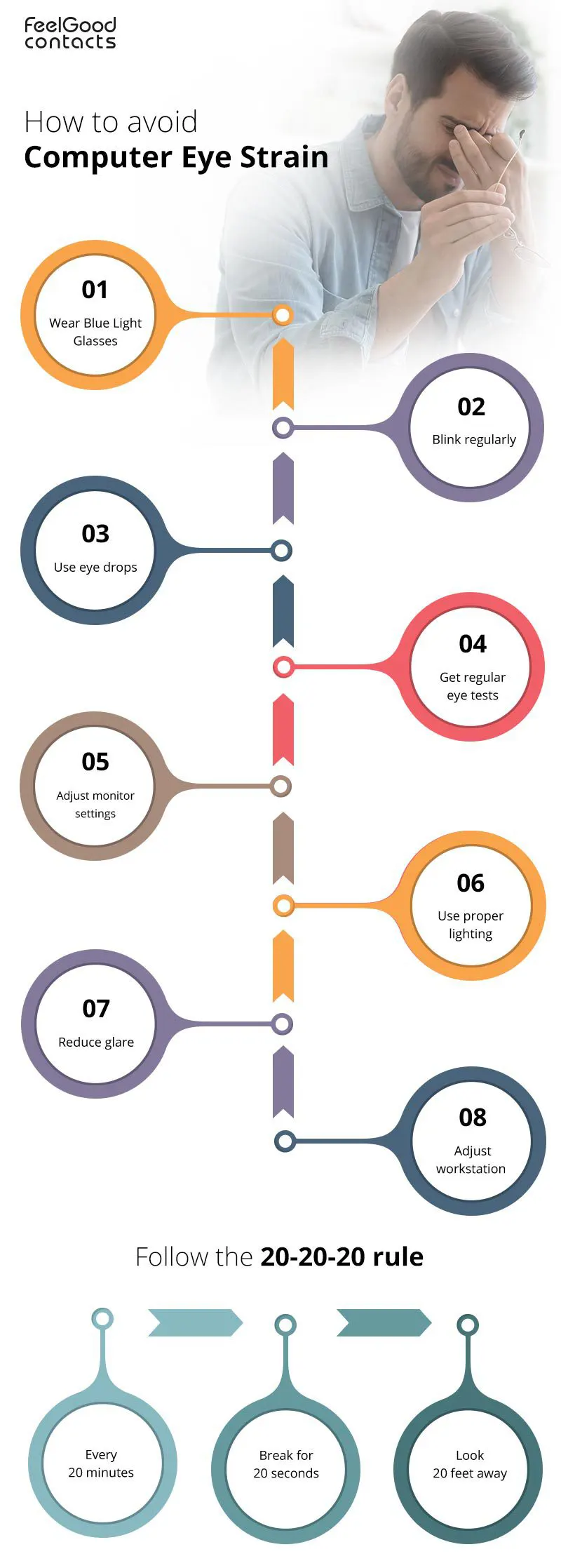
While anti-fatigue lenses are a powerful tool for combating digital eye strain, the optical market offers various solutions. Understanding the key differences between these options is essential for selecting the correct technology for your specific visual needs.
Anti-Fatigue Lenses vs. Progressive Lenses
At first glance, anti-fatigue and progressive lenses seem similar because both feature power variations. However, they are engineered for entirely different users and address distinct visual challenges.
Target User: Pre-Presbyopia vs. Established Presbyopia
The primary distinction lies in the target user. Anti-fatigue lenses are designed for individuals in the pre-presbyopia stage, typically those in their 20s and 30s who have excellent distance vision but experience eye strain from prolonged near work.
Progressive lenses, conversely, are for users with established presbyopia, a natural age-related condition that usually begins after age 40. These individuals require significant power assistance to see clearly up close, in addition to correction for distance vision.
Design: Subtle Boost vs. Full Power Corridor
This difference in purpose dictates their design. An anti-fatigue lens incorporates a subtle, fixed power boost (e.g., +0.60 Diopters) in the lower zone. This provides a small amount of magnification to relax the eye’s focusing muscles during screen use.
Progressive lenses feature a “full power corridor,” a seamless gradient of increasing magnification from the top of the lens to the bottom. This complex design provides clear vision at all distances—far, intermediate, and near—to fully compensate for the eye’s diminished focusing ability in presbyopia.
Anti-Fatigue Lenses vs. Blue Light Glasses
Another common comparison is with blue light blocking glasses, as both are marketed for computer users. Yet, they function in fundamentally different ways to alleviate digital discomfort.
Function: Accommodation Support vs. Wavelength Filtering
The core function of anti-fatigue lenses is to provide accommodation support. They directly reduce the muscular effort your eyes exert to maintain focus on nearby digital screens, tackling the physical root of eye strain.
Blue light glasses, on the other hand, operate on the principle of wavelength filtering. They are coated with a special filter that blocks or absorbs a portion of the high-energy visible (HEV) blue light emitted from screens, which some studies suggest can disrupt sleep patterns and contribute to eye fatigue.
A Combined Approach: Lenses with Integrated Blue Light Filters
Crucially, these two technologies are not mutually exclusive. In fact, the most comprehensive solution for digital eye strain often involves a combined approach. Modern optical technology allows for anti-fatigue lenses to be manufactured with integrated blue light filters. This powerful combination tackles both muscle fatigue and light exposure simultaneously. When you’re choosing your next pair, it’s worth exploring all the features available for the specific spectacles to buy online to ensure you get a truly customized solution.
By understanding these distinctions, you can make a more informed decision about your eye care. To find a solution tailored to your symptoms—whether you need simple accommodative support or a combined approach—you can explore a range of specialized advanced anti-fatigue lenses. Reviewing these options will help you select the exact lens technology that aligns with your visual demands in our digital world.
A Commercial Guide to Anti-Fatigue Glasses
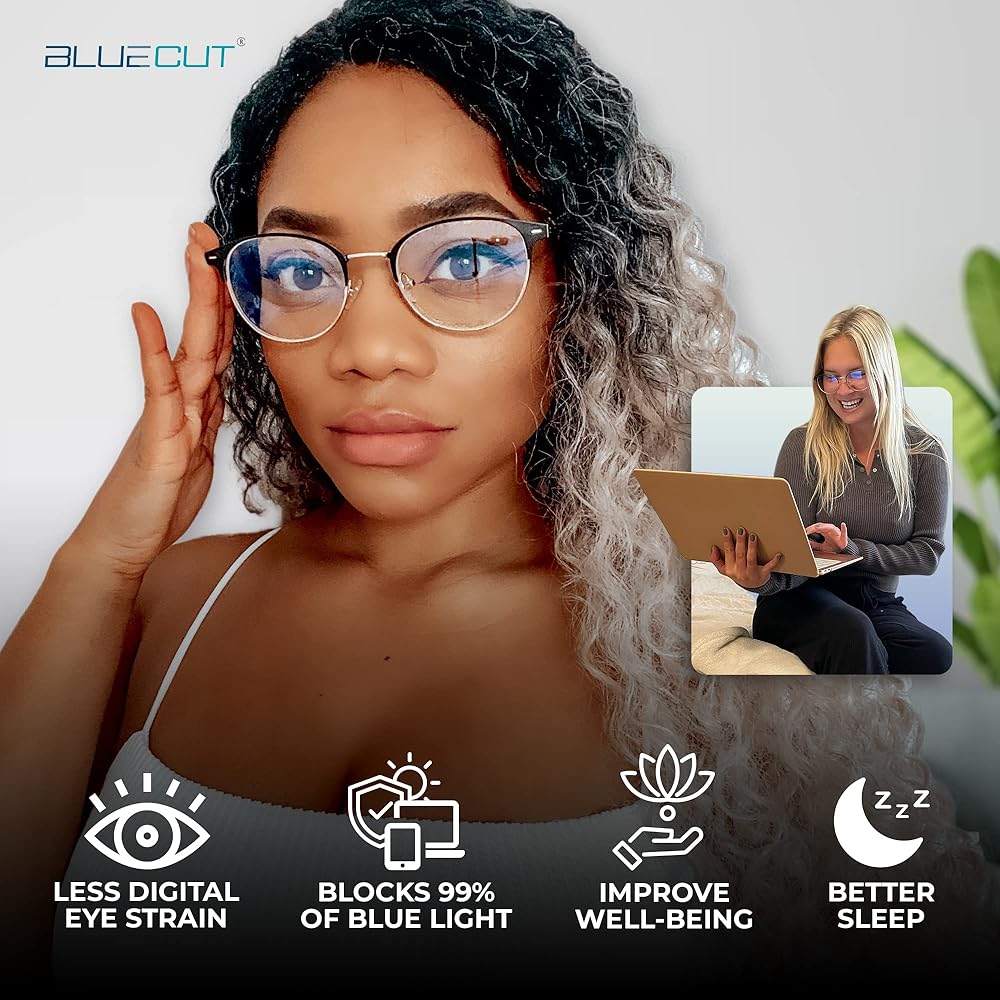
When you decide to invest in a solution for digital eye strain, navigating the market can be challenging. Leading optical brands have developed proprietary technologies to address this modern problem. Understanding the key players and their products is the first step toward making an informed purchase.
Leading Brands and Product Examples
Different manufacturers approach the challenge of accommodative support with unique lens designs and technologies. Brands like Essilor, Zeiss, and Tokai are at the forefront, each offering a distinct solution tailored to the needs of screen-heavy users.
Essilor Eyezen Lenses Review
Essilor’s Eyezen lenses are specifically engineered for people who spend hours on smartphones, tablets, and computers. Their core feature is the “Focus” technology, which provides a subtle power boost in the lower portion of the lens. This design reduces the focusing effort your eyes must exert for near tasks, directly combating muscle fatigue. Eyezen lenses also incorporate a Smart Blue Filter, which filters out specific wavelengths of harmful blue-violet light.
Zeiss Digital Lenses and ClearView Technology
Zeiss, a renowned name in optics, offers its Digital Lenses for individuals in their 30s and 40s who are new to eye strain symptoms. The design is optimized for the viewing distances of digital devices. Their ClearView technology ensures exceptional clarity from the center of the lens to the periphery, minimizing the visual distortion common in standard single-vision lenses. This provides a comfortable, wide field of vision for a seamless experience.
Jai Kudo Wideview Confidence Boost
Jai Kudo markets its Wideview Confidence Boost lenses as a solution for tired eyes in a digital world. As the name suggests, their primary focus is on providing an exceptionally wide, distortion-free field of vision. This technology helps the eyes feel more relaxed and natural when switching focus between different distances, making them an excellent choice for dynamic work environments that involve both screen time and other tasks.
Tokai Rest R Anti-Fatigue Lenses
Tokai, a leading Japanese lens manufacturer, offers the Rest R series of anti fatigue lenses. These lenses are designed with advanced optical principles to support the eye’s ciliary muscles, which are responsible for accommodation. The Rest R design provides gentle assistance for near vision, effectively reducing the strain associated with prolonged focus on digital screens and close-up reading.
Key Features to Look For When Buying Anti-Fatigue Lenses
Beyond the brand name, the specific technical features of anti fatigue lenses determine their performance and suitability for your needs. Understanding these features will empower you to select the optimal lens for your lifestyle.
Available Addition Powers (e.g., +0.50D to +1.25D)
The “addition power,” or power boost, is the heart of an anti-fatigue lens. It refers to the small amount of magnification added to the bottom of the lens, measured in diopters (D). This boost typically ranges from +0.50D to +1.25D. The correct power depends on your age and the severity of your eye strain; an optometrist will recommend a lower power for younger users and a slightly higher one for those approaching presbyopia.
Back Surface Aspheric vs. Dualoptim Technology
Lens design significantly impacts visual quality. A Back Surface Aspheric design places the lens’s complex curvature on the surface closer to your eye. This reduces peripheral distortions, creating a wider field of clear vision and allowing for a thinner, lighter, and more aesthetically pleasing lens. More advanced lenses may use Dualoptim Technology, which optimizes both the front and back surfaces. This dual-surface approach provides even greater visual precision and comfort across the entire lens.
Integrated UV and Blue-Violet Light Protection
Comprehensive eye protection goes beyond just focusing support. Top-tier anti fatigue lenses include integrated protection against invisible light. This means the UV and blue-light filtering properties are part of the lens material itself, not just a surface coating that can scratch off. This provides durable, full-time protection from harmful blue-violet light from screens and ambient UV radiation from sunlight, even when indoors. While these lenses protect you during work, it’s equally important to use dedicated protective eyewear like high-quality mens sunglasses for extended outdoor activities to ensure complete eye safety.
To ensure you get the right combination of brand technology and essential features, it’s crucial to review a variety of options. Exploring a curated selection can help you compare these features side-by-side. To find the specific addition power, lens design, and integrated protection that will best alleviate your digital eye strain, you can browse a diverse collection of customizable anti fatigue lenses.
Your Definitive Guide to Choosing Anti-Fatigue Lenses
In our digitally-driven world, combating visual fatigue has become essential for daily comfort and productivity. This guide has established that anti-fatigue lenses are a scientifically-backed, highly effective solution specifically engineered for this modern challenge.
Here are the crucial takeaways to empower your decision:
-
Target Audience: These lenses are primarily designed for pre-presbyopic individuals (typically aged 18-45) who experience symptoms of digital eye strain from prolonged use of computers, smartphones, and other screens.
-
Core Technology: Their function is rooted in accommodation support. A subtle power boost (+0.40D to +1.25D) in the lower portion of the lens reduces the demand on your eye’s ciliary muscle, preventing the fatigue, headaches, and blurred vision associated with near-vision tasks.
-
Proven Efficacy: The value of anti-fatigue lenses is confirmed by both clinical research, such as the Alionis et al. (2020) study showing a significant reduction in asthenopia, and strong market adoption, with millions of users already benefiting from this technology.
-
Key Distinctions: They are not the same as progressive lenses, which are for established presbyopia and feature a full power corridor. They also differ from standard blue light glasses, as they address muscle strain rather than just filtering light—though both features can be combined for comprehensive protection.
-
Making an Informed Choice: When purchasing, consider leading technologies from brands like Essilor, Zeiss, and Tokai. Pay attention to essential features such as the prescribed addition power, advanced aspheric lens designs for edge-to-edge clarity, and integrated UV and blue light protection for overall eye health.
Investing in anti-fatigue lenses is a proactive step toward preserving your visual comfort. By understanding how they work and who they are for, you can confidently select a pair that will make your time in front of a screen significantly more comfortable and less strenuous.
Leave a Reply